In our 12th Annual Shaolin Special, Gregory Brundage presented his second report on the construction of the Northern Shaolin Temple on Panshan (Pan Mountain) in China. As that issue was hitting the newsstands, Brundage returned to Panshan, and brings us this update.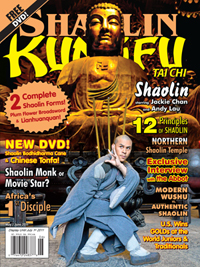
April, 2011
In June of 2010 reconstruction was suspended on the Northern Shaolin Temple and had not resumed as of April 2011. However, heavy construction was underway on the freeway interchange a couple of kilometers away. Issues involving the disposition of the villagers and the cutting of trees seem to be at the forefront of this delay. Villagers are asking for a government investigation to find out what is necessary to get the project back underway.
On Monday, April 4, my translator and I set out from Beijing for Tienjin to meet Professor Gao Wenshan, the primary researcher to discover the true location of the Northern Shaolin Temple in Jixian County. We spent a lovely afternoon and evening sipping tea nearly half a kilometer above the city in Tienjin's spectacular rotating radio and TV tower. Gao told us of his investigative work and long experience as a Shaolin wushu and taiji instructor. The next day we went to the construction site of the Shaolin Temple. Met by a number of local residents, we spent the afternoon in the "Tower Forest."
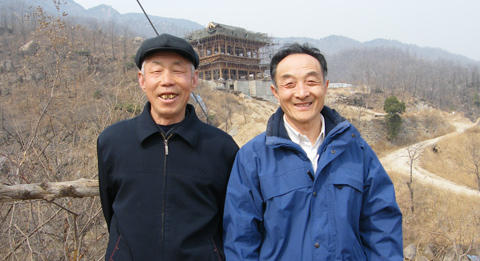
Shaolin Master Shang Baoliang and Gao Wenshan
About Gao Wenshan-Master of Many Arts
Born in Shen Yang City within Liao Ning province, Gao Wenshan was inspired by kung fu shows he saw as a child. At the age of six he started formal wushu and tai chi training in Shaolin. He was with the first group of wushu trainees in the Masters study program of physical education at Shanghai Tiyu University.
In 1979 he started training with Master Cai Long Yun for three and a half years. He recalls training all day, beginning before sunrise-even wearing shorts in the winter-and then reading until midnight. "Those were hard years," he said. "Sweat and salt" were his best friends.
Gao's interest in the location of the Northern Shaolin really started in about 1980. He was doing a wushu tour which included a large tournament with his teacher (Cai) in Fujian and was told that their Shaolin was not the "real" Shaolin. This made him curious about what the "true" styles of Southern and Northern Shaolin were, as compared to their various offshoots.
In 1983 he started teaching in the Tianjin University Physical Education Department. He retired in 2007, though he still teaches masters classes in various styles of traditional wushu at the Tianjin Sport Institute.
Clues he used to find the true temple included a map in Tongzhi from the Qing Dynasty with the North Shaolin in the center. He also found 25 poems by Emperor Qiang Long about the Northern Shaolin. Some of the walkways within the Shaolin were constructed by that emperor, who was a frequent visitor. He also had a variety of pictures and paintings from before the Japanese burned the Temple and surrounding areas. There were also records in the "Jixian Xian Shi", sort of a county record book. The old name of the temple was "Faxing Temple" before the Yuan dynasty in the 13th century. But his most valuable resources were human, villagers around the temple that were very old, and whose parents and grandparents recalled the temple in its former glory.
Though 65 years old, Gao stands straight as a Marine and moves with the agility and strength of a man in his prime. After lunch on Panshan he demonstrated one of his Shaolin forms, and his punches and kicks snapped in the air as loud as cracks of a whip.
While driving up to the Shaolin Temple from Tienjin, I asked if tai chi and Shaolin were opposites on the spectrum of Chinese martial arts, i.e., soft (internal) vs. hard (external) styles. He stretched out his arms in two semi-circles like a hug and touched his fingers in a big circle. "They use different paths," he said, "but attain the same goal."
During the drive my translator was talking with his wife in the back seat, and I found out that Gao actually does speak pretty good English, which was something of a relief given my rather rudimentary Chinese. I'd heard before that his Japanese was even better. Gao Wenshan is indeed a soft-spoken master of martial arts and human relations. In addition to his above-mentioned skills, he's also an accomplished photographer. At his house the previous evening he showed me some of his collection of photos; they were beautiful, meaningful and wordlessly spoke to the heart.
The Dilemma
On April 5, Gao, his wife, my translator and I set out on another journey to Panshan Mountain, the site of North Shaolin. Arriving around 11:00 am, we first visited the home/villa hotel of Mr. Wei Min perched halfway up Panshan. Joining us for a splendid lunch was Shang Baolian, 6th generation master of Northern Shaolin kung fu (one of his more illustrious ancestors was Shang Shi Zhi, famous for teaching Shaolin kung fu around China), and Jin Tie Jun, a reporter with the Jixien TV broadcasting station. As we ate, we talked about the situation surrounding the halted construction.
"It's not only a matter of moving the villagers," one man said. "So many trees have been cut, and in some cases we don't even know who cut them. Now the fee to even visit the temple area has jumped to 130 yuan (around $20.00) whereas before it was only 40 yuan. This increase is to pay for the road the government built but it seems excessive. Many groups of Chinese come to visit but this fee is too much." (The average income in China is only about $4,283 per year, with millions of people earning less than $200 per month).
The need for the central government to investigate the situation and get negotiations restarted was voiced by all. It appears three major parties are involved: The villagers, the Shaolin and Tienjin County government. The villagers really want the central government to come in and advocate on their behalf.
It was reported in Kung Fu Tai Chi magazine (May/June 2011) that villagers around the Songshan Mountain Shaolin were forcibly relocated, "…one of Yongxin's first moves as Abbot." Though the good Abbot still defends that decision as correct, one can wonder if he is considering a different path for the Northern Shaolin. Is he giving villagers on Panshan time to reconsider voluntarily moving to the very beautiful town that was built at the foot of that historic mountain? If so, it appears their decision has already been made, and they are not willing to voluntarily move.
What many may see as a "shabby chaotic village" is a beautiful traditional paradise to those that live there. Could the houses be remodeled, and harmonized with a new Shaolin Temple? Many questions remain unanswered.
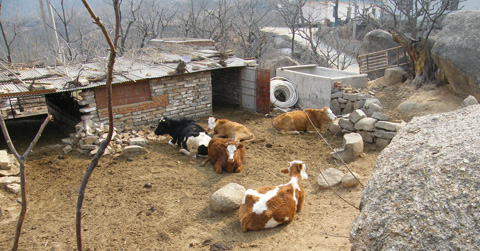
American oil companies have often faced similar dilemmas, and in more recent "enlightened" times have opted to spend sometimes vast amounts of money to alter the pathways of pipelines to accommodate the perceived needs of local people to preserve sacred, traditional and otherwise special places.
This dilemma is not a new one. Some could accuse the villagers of being greedy, demanding too much for their houses, whereas others could accuse Shaolin of being greedy capitalists destroying the villagers' lives and cultures for the sake of progress and potential revenue. This is an eternal conflict: progress vs. tradition. Hopefully all parties will reach a compromise in the end, a coalition of forces dedicated to the common goal of preserving individual interests while promoting the common good. However, in most cases, and everywhere in the world, progress wins.
There is a very popular new song in China about this dilemma called, "Destroy the East Wall. It relates the story of a man who owns a wine shop which has been in his family for generations. He is offered a fortune by a developer to sell it, and finally he does. The melody and singing are beautiful, and there are hints of humor amid the larger theme of sadness in the story. In the end he is destroyed along with his wine shop. There is even a short phrase in Chinese, "Ding zi hu," which succinctly describes the conflict between the need to preserve the old and the need to flatten it to make way for the new. Of course, this is a conflict experienced everywhere in the world. I remember a song from the '70s with the words, "They paved paradise to put up a parking lot," by Joni Mitchell.
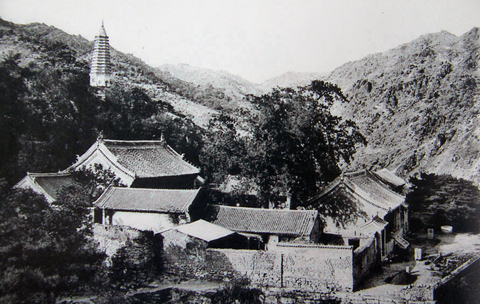
1 Photo of North Shaolin before its destruction in 1942
Karma or coincidence?
April 5 was also a special holiday in China called "Tomb Sweeping Day" (Qing Min Jie). After lunch our group went to the construction site, and indeed nothing had changed whatsoever from my last visit. So, Professor Gao and company took us to another very special place, the Shaolin's "Ta Lin," which literally means "tower forest" but is actually their traditional cemetery.
Apricot flowers bloomed in the mid-spring afternoon while the buds of tree leaves gave promise of another rebirth in this sacred place covered by high thin clouds and massaged by gentle cool breezes.
Shaolin follows ch?n (Zen) Buddhist traditions and words can never capture this true natural phenomenon. Honey bees hovered in their unpredictable ways, gathering nectar from wild flowers while the spirits of unnamed Northern Shaolin monks and abbots rested peacefully.
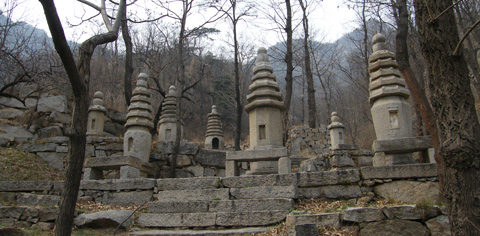
Enclave in the Shaolins Ta Lin
LUO YIN (833-909)
Honey Bees
Either at the peak or on the level soil,
Their invasion of our boundless nature we cannot foil.
After gathering honey from a hundred flowers,
For whose sweet tooth is their toil?
One legendary person who may be buried there is Fuyu (1203 - 1275), a Chan master in the early Yuan dynasty. He was appointed abbot by the first emperor of the Yuan Dynasty, Kublai Khan, and did much to propagate Chan Buddhism and Shaolin as well as bringing unparalleled prosperity to the temple. He died at the age of 73. According to the Shaolin internet site, he was buried in the "Pagoda Forest" (Ta Lin).
The cemetery has been partially restored in recent years by an American Chinese couple from Texas who visit every year along with their children. They stay a week or two-as long as they can- and work hard before returning to their lives and jobs so far away. They also donate money to the temple fund to help in restoration. But, so much remains to be done. Their work is like triage, a preliminary restoration to slow the crushing wheels of time's effects on all things.
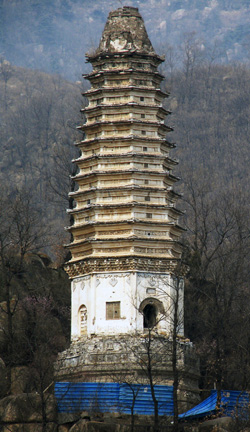 According to the villagers living around the temple, the actual destruction of the North Shaolin Temple occurred during the late summer and early fall of 1942. So terrible was the destruction that nothing remained except the very large white pagoda. Battles raged for weeks, with monks and villagers fighting together in and around the temple and later in the numerous caves in the area. During the daytime they hid in the caves, and at night they fought. The battle of Jixian was called "Zong Da Bao Dong." Nothing had been done since that awful time to restore the Shaolin's Ta Lin until this Chinese American couple arrived.
According to the villagers living around the temple, the actual destruction of the North Shaolin Temple occurred during the late summer and early fall of 1942. So terrible was the destruction that nothing remained except the very large white pagoda. Battles raged for weeks, with monks and villagers fighting together in and around the temple and later in the numerous caves in the area. During the daytime they hid in the caves, and at night they fought. The battle of Jixian was called "Zong Da Bao Dong." Nothing had been done since that awful time to restore the Shaolin's Ta Lin until this Chinese American couple arrived.
High above the far end (upper part) of the cemetery there are huge rocks on the mountainside, including a large level rock above which is written in very faded Chinese: "Speaker's platform." The ancient path leading up there was obscured by decades of wild plant growth, and needed a little rock climbing to ascend. One could imagine that the speakers at the funerals for Shaolin abbots and monks had to be rather spry fellows!
Time collapsed in the apricot grove cemetery, and all too soon it was time to return again to that which we modern people call reality-though I for one know that a part of me will always remain in the peace and serenity of the Panshan Shaolin's Ta Lin. This sacred grove is a healing place for the souls of men.
On the return path Wei Min mentioned that the American man who brings his family every year to work on restoration of the cemetery had suffered numerous health problems, but sitting in the grove his ailments disappeared and health returned. It would appear that this sacred place, so blissfully escaping the march of progress, provides a focus for healing.

At the front of Shaolins Ta Lin
Following the path back from the eternal resting place, I pondered: Today is Qing Min Jie (Tomb Sweeping Day). Is it a coincidence that Gao brought us here today, to this cemetery of the ancient Shaolin masters? Most Chinese I have met believe in destiny, and who can ever calculate the probabilities involved in the chains of cause and effect that led us to this particular place on this particular day?
CHENG HAO (1032-1085)
A Casual Verse on a Spring Day
With thin clouds and light winds, near midday,
By bloom and willow, I cross the front stream on my way.
Bystanders know not my heartfelt joy.
That I slack off like a juvenile, they will say.

Shaolin Abbot Shi Yongxin hosting Gao Wenshan for tea.
For Rebuilding the Northern Shaolin Temple: Part 4: Chinese New Year of the Dragon, click here.
About
By Gregory Brundage (translations Miao Hui) :
![]() As a boy going to schools in different countries, Mr. Gregory Brundage had to fight a lot. At age 12 he started judo, and after that wushu. Since then he's fought in more than 300 martial arts tournaments. He's worked at a variety of jobs, ranging from farming and construction work to university lecturer. He is currently a?teacher in Beijing.
As a boy going to schools in different countries, Mr. Gregory Brundage had to fight a lot. At age 12 he started judo, and after that wushu. Since then he's fought in more than 300 martial arts tournaments. He's worked at a variety of jobs, ranging from farming and construction work to university lecturer. He is currently a?teacher in Beijing.
![]() Print Friendly Version of This Article
Print Friendly Version of This Article
















